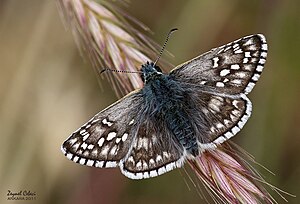Gray-brown thick-headed butterfly
| Gray-brown thick-headed butterfly | ||||||||||||
|---|---|---|---|---|---|---|---|---|---|---|---|---|

Gray-brown thick-headed butterfly ( Pyrgus sidae ) |
||||||||||||
| Systematics | ||||||||||||
|
||||||||||||
| Scientific name | ||||||||||||
| Pyrgus sidae | ||||||||||||
| ( Esper , 1784) |
The gray-brown thick-headed butterfly ( Pyrgus sidae ), also known as the yellow cube-shaped thickhead , is a butterfly from the family of the thick-headed butterfly ( Hesperiidae ).
features
The fore wing length is 16 to 18 millimeters. The top is dark brown with gray hair on the wing roots. On the forewings there is a large cell spot and a number of small and often indistinct submarginal spots . Bright spots can be seen on the hind wings. The underside of the hind wings is white, the disk and post disk bands are yellow. Both sexes have the same wing markings, but the hair of the female is less strong.
The round eggs are slightly flattened above and below. The surface is covered with about 15 strong, mostly straight or occasionally slightly curved longitudinal ribs emanating from the micropyle. On the side, shorter longitudinal ribs can intervene.
The caterpillar is initially greenish, later also gray or red-brown with a black head.
The pupa is already dense bluish. The brown basic color can only be seen at the segment boundaries of the abdomen. The black drawing, a longitudinal line on the thorax and a dot pattern are only faintly visible through the tires.
Geographical occurrence and habitat
The gray-brown thick-headed butterfly is from the Iberian Peninsula (here only an isolated occurrence in the Sierra de Gredos ), south-east France, the north-western coastal areas of Italy , central Italy, Istria ( Slovenia and Croatia ) and the Balkan Peninsula , via Turkey , Transcaucasia , Iran to Afghanistan spread. In the north, the distribution area extends over the southern Urals to the northwest of Kazakhstan and the west of the Tienschan . The moths can be found in flower-rich places at altitudes of 50 to 1750 meters, mostly over 600 meters.
The nominate subspecies Prygus sidae sidae occupies the largest part of the distribution area . The subspecies Pyrgus sidae occiduus (Verity, 1925) occurs in Spain in the Sierra de Gredos (700 to 1300 meters), in south-east France, in the north-western coastal areas of Italy and in Croatia on the Istrian peninsula (100 to 1400 meters).
Way of life
The species forms one generation per year, the moths of which fly from mid-May to late June. In northeast Greece, the moths fly near sea level from the beginning of April to May. The females lay the eggs between the stamens of the flowers of the host plant. In Greece the caterpillars live on high cinquefoil ( Potentilla recta ) and Potentilla hirta . The caterpillar takes a summer rest in summer as L3, which lasts until the first autumn rains. Then the caterpillar becomes active again and eats the freshly sprouting leaves. It sheds its skin one more time and hibernates as an L4 caterpillar. It pupates the following spring.
The moths of the subspecies Pyrgus sidae occiduus fly from mid-June to early July.
Systematics
The species is currently divided into two subspecies:
- Pyrgus sidae sidae (Esper, 1784) and
- Prygus sidae occiduus ( Verity , 1925)
The type locality of the species or the nominate subspecies is located on the Volga in southern Russia . The type locality of the subspecies P. sidae occiduus is Tuscany (Italy). The latter differs from the nominate subspecies by the paler yellow bands on the underside of the hind wings and the less distinct speckled pattern on the upper side of the forewings. In addition, the moths are smaller. There are intermediate forms between the two subspecies.
swell
Individual evidence
- ^ Lionel G. Higgins, Norman D. Riley: The butterflies of Europe and Northwest Africa . 1st edition. Paul Parey, Hamburg / Berlin 1978, ISBN 3-490-01918-0 , pp. 282 .
- ↑ a b c d e Tom Tolman, Richard Lewington: The butterflies of Europe and Northwest Africa . Franckh-Kosmos, Stuttgart 1998, ISBN 3-440-07573-7 , p. 257 .
- ↑ Ottokar Kudrna (Ed.): The Distribution Atlas of European Butterflies . 1st edition. Apollo Books, Stenstrup 2002, ISBN 87-88757-56-0 , pp. 277 (English).
- ^ Pyrgus sidae (Yellow dice head). Wolfgang Wagner, accessed on January 15, 2010 .
literature
- Lionel G. Higgins, Norman D. Riley: The butterflies of Europe and Northwest Africa . 1st edition. Paul Parey, Hamburg / Berlin 1978, ISBN 3-490-01918-0 .
- Tom Tolman, Richard Lewington: The butterflies of Europe and Northwest Africa . Franckh-Kosmos, Stuttgart 1998, ISBN 3-440-07573-7 .
- Ottokar Kudrna (Ed.): The Distribution Atlas of European Butterflies . 1st edition. Apollo Books, Stenstrup 2002, ISBN 87-88757-56-0 (English).
- Wolfgang Wagner: The genus Pyrgus in Central Europe and its ecology - larval habitats, nutrient plants and development cycles . - In: T. Fartmann & G. Hermann (Eds.): Larval ecology of butterflies and rams in Central Europe. Treatises from the Westphalian Museum of Natural History, 68 (3/4): 83–122, Münster 2006 PDF .
Web links
- Art portrait at pyrgus.de
- Lepiforum e. V. Taxonomy and Photos (English)
- Fauna Europaea
- Moths and Butterflies of Europe and North Africa